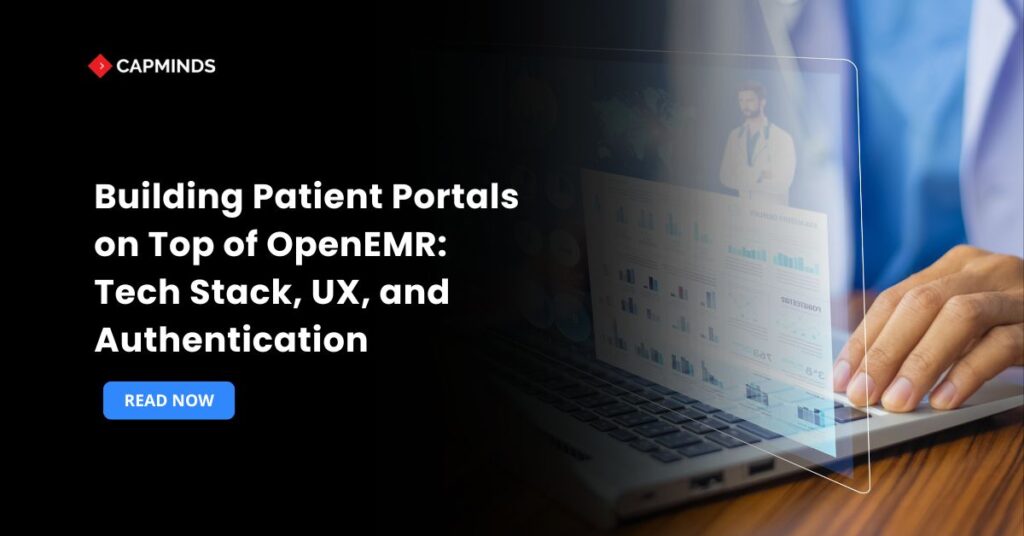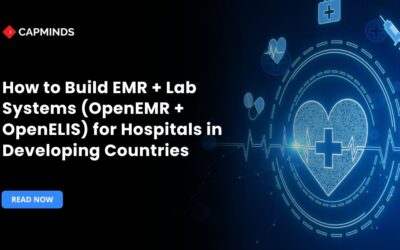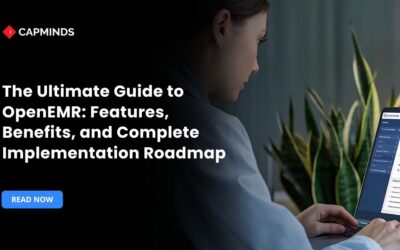Building Patient Portals on Top of OpenEMR: Tech Stack, UX, and Authentication
Patient portals have become the foundation of efficient patient engagement and care coordination in today’s healthcare environment. A well-integrated portal allows users to access their health data, communicate with providers, manage appointments, medications, and billing.
Creating a customized patient portal can be a strategic extension for practices that use OpenEMR. In this blog, you’ll learn the technological foundation, UX concerns, and authentication procedures required to create strong and secure patient portals on top of OpenEMR.
1. Choosing the Right Technology Stack
Selecting the right technology stack establishes the foundation for maintainability, performance, and scalability. The following are the major components you’ll need to evaluate.
Backend Frameworks and Languages
OpenEMR‘s core is built in PHP; therefore, extending or connecting directly via PHP modules can make integration easier.
- Node.js / Express – For teams who prefer JavaScript, a Node.js layer can serve as an adaptor or middleware for OpenEMR’s REST or FHIR APIs. This separation may also help microservices adoption.
- Python / Django or Flask – Python frameworks are widely used in healthcare for data analytics and quick prototyping. Another option is to use a Python service layer to coordinate OpenEMR API calls and handle data such as HL7 messages.
API Layers and Interoperability
OpenEMR 5.0+ includes a built-in REST API with endpoints for patient demographics, interactions, issues, and more. Use these directly for CRUD tasks.
- Fast Healthcare Interoperability Resources – Use the OpenEMR FHIR interface or a separate FHIR server like HAPI FHIR as an intermediate to ensure compliance with current interoperability standards.
- HL7 v2 Messaging – For older integrations, utilize an HL7 engine such as Mirth Connect to convert and route messages between OpenEMR and other systems.
Front End Technologies
React, Vue.js, and Angular are single-page application frameworks that provide a responsive and app-like user experience. React remains popular because of its ecosystem, although Vue.js is popular for its ease of use.
- CSS frameworks like Tailwind CSS and Bootstrap provide responsive grids, utility classes, and prebuilt components to speed up style and create mobile-friendly layouts.
- Consider Material-UI like React or Vue for uniform design, accessibility, and theming support.
Database & Caching
Primary Data Store
While patient data is stored in OpenEMR’s MySQL/MariaDB database, your portal may require its database, such as PostgreSQL, to cache session data, user preferences, or audit logs without affecting core EHR tables.
Caching Layer
Use Redis or Memcached to cache frequently accessed records, such as lab results information, for quicker page loads and lower backend load.
Hosting & DevOps
- Containerization – Dockerize each service like OpenEMR, API layer, and frontend, to enable microservices deployment.
- Orchestration – Kubernetes or Docker Swarm can handle scalability, health checks, and automated deployments.
- CI/CD Pipelines – Use GitHub Actions, GitLab CI, or Jenkins to automate testing, linting, and deployment, therefore improving code quality and minimizing downtime.
2. Developing a User-Centric UX
The success of a portal is determined by how easy and engaging it is for patients to use. The user experience approach must strike a balance between simplicity, accessibility, and functionality.
Information Architecture
- Dashboard Overview – Upon login, show a concise overview of upcoming appointments, unread messages, recent test results, and payment status.
- Modular Navigation – Use role-based menus like adult patients, pediatric proxies to display only relevant portions and reduce cognitive overload.
Responsive and Accessible Design
- A mobile-first approach, given the presence of smartphone usage, provides components that adapt elegantly to tiny screens, including touch-friendly controls and properly scaled typefaces.
- WCAG compliance involves making interactive items keyboard-accessible, including ARIA labels, and maintaining enough color contrast. This not only benefits people with impairments but also reduces legal concerns.
Key UX Features
Secure Messaging
A mailbox interface that looks like a popular email client, including folders for inbox, sent, and archived. Include in-line attachment previews and read receipts.
Appointment Scheduling
Add calendar widgets that show open times with provider, location, and appointment type criteria. Email or SMS reminders and confirmations can be sent automatically.
Lab Data Visualization
To improve comprehension, display quantitative data in tables with reference ranges and provide trend charts like blood sugar over time.
Bill Pay & Statements
Offer balance-bearing patients payment options, accept online payments using PCI-compliant gateways, and provide itemized statements.
Personalization and Engagement
Notification & Alerts
Receive push alerts through the mobile app or email about vital lab results, appointment reminders, and new communications.
Educational Resources
Contextual links to publications or videos relevant to a patient’s condition, and diabetes care advice following blood sugar results.
Feedback Mechanisms
Short surveys administered after a visit or after utilizing a portal function allow for continual development based on genuine user input.
Related: 7 UI/UX Enhancements in OpenEMR That Elevate Healthcare Delivery
3. Implementing Robust Authentication
Authentication acts as the portal’s gatekeeper, combining ease of use for legal users with security against unauthorized access. Given the sensitivity of PHI, your approach should be both user-friendly and compliant.
Authentication Protocols
OAuth 2.0/OpenID Connect – Set up an OAuth 2.0 authorization server such as Keycloak, Auth0, or a custom solution. OIDC offers an identity layer for safe, standards-based logins and token issuance.
JSON Web Token – For session tokens, use signed JWTs. To minimize XSS and CSRF attacks, store them securely in HTTP-only cookies with the proper SameSite characteristics.
Multi-Factor Authentication
SMS/Email OTPs
Sending one-time passcodes through SMS or email adds an added degree of protection. However, be aware of possible SIM swapping or email compromise issues.
TOTP Applications
Encourage users to utilize authenticator applications such as Google Authenticator. This approach is less susceptible to interception than SMS.
Account Recovery and Self-Service
Secure Password Reset
Send a time-limited, single-use reset link to the user’s confirmed email. Require strong new passwords, consider passphrases, or incorporate a password strength meter.
Biometric Options
If you have a native mobile app, employ device biometrics such as Face ID, fingerprint via the app’s secure environment to make login easier for regular users.
Session Management and Security
- Idle Timeout – Automatically logs users out after a preset time of inactivity for 15 minutes, with clear warning messages.
- Device Management – Allows users to examine and cancel active sessions, including device kind, IP address, and location information.
Enforce TLS 1.2+ for all connections. Use AES-256 or a comparable algorithm to encrypt sensitive data at rest, like tokens, cache entries.
Compliance and Audit Trails
HIPAA Considerations
Make sure your authentication logs include the user ID, date, IP address, and action type, like login success, unsuccessful attempt, or password change. Logs must be tamper-evident and stored under regulations.
Role-Based Access Control
Even within the portal, differentiate permissions for caregivers vs. patients, so that only authorized users may read certain records.
4. Integrating Everything – A Sample Architecture
- User Device – The SPA frontend is created in React or Vue and handles routing and UI. Native mobile applications like iOS and Android can be integrated using REST and push notifications.
- Authentication Server – OAuth 2.0 / OIDC compatible, with JWTs generated upon successful login. Manages user profiles, multi-factor authentication settings, and password resets.
- API Gateway & Middleware – Validates tokens, applies rate limitations, and redirects requests to backend services. Implements caching and request aggregation.
- Business Logic Layer – Microservices written in Node.js or Python coordinate calls between the API gateway and the ultimate data source. Performs data manipulations such as preparing lab findings for charts.
- OpenEMR Core – Serves as the authoritative source for patient information, appointments, billing, and communications. Provides native REST and FHIR endpoints.
- Data Stores – MySQL/MariaDB for EHR. Use PostgreSQL or MongoDB for portal-specific info. Redis handles session and cache management.
- DevOps, Monitoring – Use Kubernetes for orchestration. Prometheus/Grafana for metrics for API latency and error rates. The ELK stack is used for centralized log analysis and alerting.
CapMinds OpenEMR Customization and Integration Service
CapMinds OpenEMR equips clinicians with the best features and ways to integrate. It makes their workflows more efficient and filtered.
The integrated features will allow them to combine the ability of patient record management with conceptual and concurrent reminders.
This enhances the process of decision-making and improves patient care and quality.
- At CapMinds, OpenEMR custom solutions are developed with much care and accuracy to match the special practice needs.
- It will be low-cost and the perfect budget solution for your practice’s long-term future.
- CapMinds OpenEMR prioritizes secure data management & ensures compliance with industry regulations, offering healthcare providers peace of mind.
Get the best technologies and HIPAA-compliant and efficient OpenEMR from CapMinds that can be tailored to fit your practice.
Our OpenEMR services facilitate a Modern User Interface (UI), customization, production support & training. It also facilitates billing, reporting, specialty enhancements, clearing house integrations, e-prescribing, cloud, and more.
“Get the most experienced, proven, and perfect professional support for your OpenEMR.”




